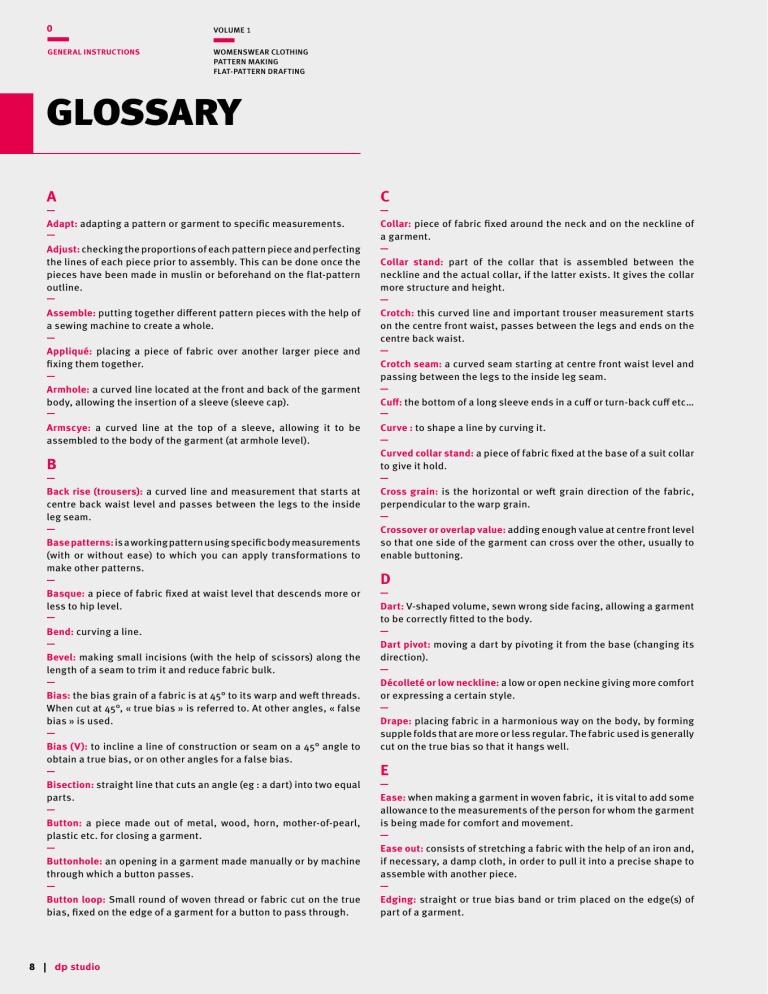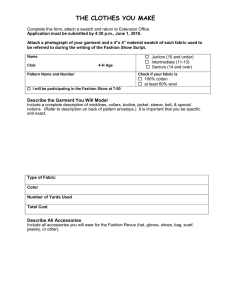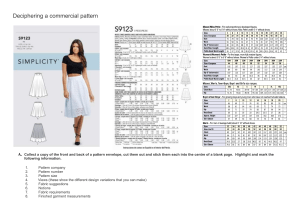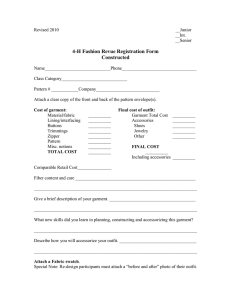
0 VOLUME 1 GENERAL INSTRUCTIONS WOMENSWEAR CLOTHING PATTERN MAKING FLAT-PATTERN DRAFTING GLOSSARY A C Adapt: adapting a pattern or garment to specific measurements. Collar: piece of fabric fixed around the neck and on the neckline of a garment. Adjust: checking the proportions of each pattern piece and perfecting the lines of each piece prior to assembly. This can be done once the pieces have been made in muslin or beforehand on the flat-pattern outline. Assemble: putting together different pattern pieces with the help of a sewing machine to create a whole. Appliqué: placing a piece of fabric over another larger piece and fixing them together. Armhole: a curved line located at the front and back of the garment body, allowing the insertion of a sleeve (sleeve cap). Armscye: a curved line at the top of a sleeve, allowing it to be assembled to the body of the garment (at armhole level). B Back rise (trousers): a curved line and measurement that starts at centre back waist level and passes between the legs to the inside leg seam. Base patterns: is a working pattern using specific body measurements (with or without ease) to which you can apply transformations to make other patterns. Basque: a piece of fabric fixed at waist level that descends more or less to hip level. Collar stand: part of the collar that is assembled between the neckline and the actual collar, if the latter exists. It gives the collar more structure and height. Crotch: this curved line and important trouser measurement starts on the centre front waist, passes between the legs and ends on the centre back waist. Crotch seam: a curved seam starting at centre front waist level and passing between the legs to the inside leg seam. Cuff: the bottom of a long sleeve ends in a cuff or turn-back cuff etc… Curve : to shape a line by curving it. Curved collar stand: a piece of fabric fixed at the base of a suit collar to give it hold. Cross grain: is the horizontal or weft grain direction of the fabric, perpendicular to the warp grain. Crossover or overlap value: adding enough value at centre front level so that one side of the garment can cross over the other, usually to enable buttoning. D Dart: V-shaped volume, sewn wrong side facing, allowing a garment to be correctly fitted to the body. Bend: curving a line. Bevel: making small incisions (with the help of scissors) along the length of a seam to trim it and reduce fabric bulk. Bias: the bias grain of a fabric is at 45° to its warp and weft threads. When cut at 45°, « true bias » is referred to. At other angles, « false bias » is used. Bias (V): to incline a line of construction or seam on a 45° angle to obtain a true bias, or on other angles for a false bias. Bisection: straight line that cuts an angle (eg : a dart) into two equal parts. Button: a piece made out of metal, wood, horn, mother-of-pearl, plastic etc. for closing a garment. Dart pivot: moving a dart by pivoting it from the base (changing its direction). Décolleté or low neckline: a low or open neckine giving more comfort or expressing a certain style. Drape: placing fabric in a harmonious way on the body, by forming supple folds that are more or less regular. The fabric used is generally cut on the true bias so that it hangs well. E Ease: when making a garment in woven fabric, it is vital to add some allowance to the measurements of the person for whom the garment is being made for comfort and movement. Buttonhole: an opening in a garment made manually or by machine through which a button passes. Ease out: consists of stretching a fabric with the help of an iron and, if necessary, a damp cloth, in order to pull it into a precise shape to assemble with another piece. Button loop: Small round of woven thread or fabric cut on the true bias, fixed on the edge of a garment for a button to pass through. Edging: straight or true bias band or trim placed on the edge(s) of part of a garment. 88 || dp dp studio studio G Enlarging: increasing the volume of a construction by adding centimetres. Excess value: excess fabric value between two notches that needs to be eased out using an iron and even a damp cloth if the excess value is significant. The larger the excess value, for example at the top of a sleeve cap, the better the finished sleeve shape. F Facing: piece of fabric used to line a neckline, armhole, pocket opening etc… to bring a clean and neat finish. Facing or faced hem: an interior finish made in the same fabric as the garment, running parallel to the garment edge. A skirt without a waistband for example, will often be finished this way. Fall (of a collar): represents the part of the collar that descends onto the garment. Flap: a lined piece of fabric placed over another part of a garment, for example a pocket flap. Flat area: a plane area or platitude of a few centimetres perpendicular to the outline to help ensure symmetrical assembly. For example, the armhole of a suit jacket is outlined on the front with a flat area of 2cm. Flat-pattern drafting: 2D technique of making patterns for clothes using paper. Flare: adding enough material to widen the bottom of a skirt, dress, trousers… Folding: action of placing one part of the fabric over another part. French curve: a plastic and curved ruler allowing the user to draw the curve shapes represented on a pattern. A longer French curve is used for trouser curves etc… French curve: a plastic and curved ruler allowing the user to draw the curve shapes of any outline. The one most often employed is french curve n°21. Frill: band of fabric added to a garment that can be gathered, pleated, cut on the bias or straight grain, in the form of a circle or spiral, creating a decorative effect. Front facing: a piece of fabric attached to the front edge of a garment before being folded to the wrong side to be hidden. It has exactly the same shape as the garment edge and contours it perfectly. The same fabric as the garment can be used or a lining fabric if the main fabric is thick. Fullness: represents the given (or extracted) volume of a pattern or garment. Gathers: Small puckers made by two parallel rows of running stitches placed along the edge of the fabric to pull it in and create extra volume. Godet: a triangular piece of fabric inset between two pieces of fabric or in-one with a seam to add volume and shape. Gore: a typically trapezoid shaped piece or panel sewn to another garment panel to create a flowing effect, often used in skirts. Gusset: inset between two or more seams to add more room, especially under the arm in the construction of a kimono sleeve. This piece is usually diamond shaped and cut on the true bias. Grading: a system allowing the increasing or decreasing of volume of a garment in one size in order to create the other sizes as accurately as possible. For example, from a size 10 a size 8, 12, 14 etc. can be obtained. H Hang: the impression a garment gives when tried on the body. When a garment is even, straight and balanced, it hangs well. Hem: finishing the edge of a garment by folding and sewing it on the wrong side of the fabric. I In-one: refers to a pattern pièce constructed as an intégral part of another piece, without a seam, for example facing constructed in one and the same pattern piece as the garment front. Invisible buttoning tab: system of closing a garment composed of buttonholes hidden under a band of added fabric or in-one with the main fabric. To inset: to insert one pattern piece into another larger piece by curving in the larger one. Inside leg: inside length of the leg measured from the front crotch to the ground (or trouser hem). L Lining: generally made out of fine fabric, this interior layer covers and finishes the inside of a garment, concealing its seams and giving the garment extra hold. M Maintain: suppressing the excess value of a piece of fabric by creating two gathered stitches to facilitate assembly with another garment part. dp studio | 9 0 VOLUME 1 GENERAL INSTRUCTIONS WOMENSWEAR CLOTHING PATTERN MAKING FLAT-PATTERN DRAFTING Mitered angle: seam made diagonally and on an angle to avoid thickness where two flaps of fabric join. This method is to be avoided if alterations might later be needed (lengthening of the garment, for example) because a certain amount of fabric is suppressed, making the lengthening of this part of the garment difficult. N Neckline: a curved opening made on upper bust level for the head to pass through. Nip: suppressing fabric on a garment, for example at waist level. This suppression can be carried out by the creation of seams and/ or darts. Piping: a narrow strip of fabric cut on the true bias and generally placed on a pocket or buttonhole opening. Piping can be single or double. Pivoting darts: moving a dart by pivoting it from the base. Pleat: a fold formed by doubling fabric back upon itself, which is then secured in place. Plumb line: a vertical line at right angles with the floor, used for determining the balance of a garment in relation to the length or crosswise grain of the fabric. The latter grains are perpendicular and parallel to the ground, respectively. O Pocket: opening incorporated in part of a garment, allowing the hand to enter. A pocket can either be appliqué or inset. When inset, this opening is prolonged by the pocket sack. On fold: when cutting part of a pattern twice, for example a skirt front, indicate ‘on fold’ for centre front so that the latter will be placed on the fabric fold and cut twice, eradicating the need for a centre front seam. Press-stud or snap: a device for closing a garment made of two pieces of metal that slot into eachother. Outline: accurately reproducing the lines and contours of a pattern on a piece of paper. This can be done : • using tracing paper to follow the lines with a pencil • using an awl to dot the pattern lines before pencilling over the dotted indents. Overlocking: assembling two pieces using an overlocking machine that first cuts the excess fabric and then joins the two pieces by an elastic overlock stitch. This method is used when working with knitted fabric that requires elasticity, or when edging the different pieces of a garment before assembly to avoid fraying. P Pair of scissors: a shearing tool for cutting fabric, consisting of two mobile blades joined together by a hand piece. Parallel: lines moving in the same direction that never touch. For example, the bust spread line is parallel to centre front. Pattern: a paper template comprising all the necessary pieces, finishes, notches and seam allowances for making a garment. The pattern outline allows the garment to be cut in fabric. R Rib: knitted rib band (elastic) used to finish the edge of a garment, for example the end of a sleeve or the neckline of a jumper. Rib can have more creative uses and be in-one with the main knitted piece. Rib can also be added, in other words sewn to the main piece. Rise: (trousers), the defined length on centre front between the waist and the base of the front crotch. Also known as the front rise. Rise: (collar) used also to express how high a collar rises. Roll line: the line where a collar folds down and the lapel or upper collar (suit, shawl etc) descends onto the garment. S Seam: allowing any part of a garment to be separated into several pieces to bring creativity or improve a shape or volume. Seam allowance value: an allowance of extra fabric that is added parallel to the edge of each pattern piece to facilitate assembly and when large enough, allow future alterations. Selvedge: edge of the fabric formed by the ends of the weft threads. Pattern-making: converting drawings into garment volumes, either by flat-pattern drafting (2D) or draping (3D). Pattern notches: notches are small indents used to facilitate the joining of two pieces of fabric, optimize the assembly process and obtain the desired volume. A notch is always perpendicular to the seam. Perpendicular: a straight line at right angles with another line. For example, the large hip line is perpendicular to centre front. 10 10 || dp dp studio studio Sheathed assembly: assemble two pieces of fabric, right sides facing, leaving one seam open to turn back onto the right side. Shift: rebalancing part of a garment or pattern by changing its grainline so that it hangs better. Shoulder pad: wadding cut in a semi circle and placed on the edge of the shoulder and beginning of the armhole to bring structure to the garment and lift the shoulder slope. Z Spread: a measurement that exists between two points, for example the bust spread (between the two bust points). Zip fastener: a fastening system composed of two parts that slot into eachother with the help of a cursor that enables the closing or opening of the zip. Square (V): to adjust a marker point on an outline so as to set it at right angles to another point or straighten it in the aim of assembling two pièces accurately. Standardization: a method to help ensure accurate assembly by checking and adjusting seam allowance value through the placing of notches at the end of each seam line. It is vital to check the length of each seam, two by two, as they must be absolutely identical. Straight grain: is the selvedge or warp grain direction of a fabric and the one in which it is rolled out (lengthwise). A garment with a centre front SG is cut parallel to the fabric selvedge. Symmetry: the position of two identical parts located either side of an axis. For example, the left front of a basic skirt can be found by placing the right side on the left of centre front. T Tab: a piece of fabric that is added, usually to dissimulate a slit or opening. Tape or tying ribbon: fine flat cotton tape, generally red or blue, cut on the straight grain, allowing a pattern-maker to indicate the major axis and construction lines on the dummy (bust, waist, large hip lines etc). This tape can also be used for finding particular shapes when making a mock-up on the dummy. Turn-up: a band of fabric folded onto the right side of the garment, creating a certain style. U Underwiring: metal or plastic strip to reinforce or give hold to different parts of a garment, for example bustiers. W Warp: lengthwise grain of a woven fabric, parallel to the selvedge. Fabric is very often cut on this grain. Weft: horizontal grain of a woven fabric, perpendicular to the selvedge. Fabric is less often cut on this grain. Widen: increase the width of a dart or seam. Open up a neckline or armhole. Y Yoke: a piece of fabric added to a garment and assembled with the rest of the garment in a way that respects its style. Yoke (trousers): a piece of fabric added below the back waistband of a pair of trousers. dp studio | 11 9. Tracing paper 1. Awl 24. Tracing wheel 39. Carbon paper 33. Blue and red tailor’s chalk 10. Compass 17. Pair of paper scissors 34.Tailor’s ham 2. Hook 25. Pair of fabric scissors 11. Metal tailor’s square 35x60cm Graphite and colour 0,5 Criterium leads 35. Sleeve-board 18. Weights 26. Rubber 36. Powder tracer 12. Plastic calibrated 60° set square with protractor 19. Sheets of white paper 65x100cm 27. Pattern notcher 37. A thimble 4. Criterium 28. 1m metallic ruler 13. Perforator with a lever 5. Suit curves 20. Cardboard for patterns 21. A grading ruler 29. Pencil sharpener 6. Vary form curve for trousers and skirts 40. Sellotape 14. Zenith Trapano 30. Muslin 22. 70cm French curve 7. Adhesive black tape 31. Tape measure 15. Drawing pins 38. A dummy 8. Red and blue tape 16. Box of pins 23. French curve n°21 32.Kapok




